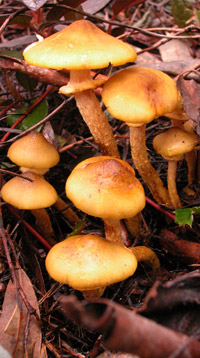Horticulture - Plant disease control
Nursery and glasshouses
Good hygiene and sanitation is the primary means for controlling plant fungal diseases in the glasshouse and nursery.
In the nursery, the benches drain well and are kept clean by regular cleaning with detergent and bleach.
In the glasshouses, the paths, walls and ceiling are kept clean by washing with a high pressure cleaner every 3 months.
Powdery Mildew is a fungal disease that can infect the glasshouses or nursery, but is kept under control with the following measures:
- pruning to remove diseased or dead material
- removing leaf litter or debris
- maintaining a good air circulation around the plants by pruning and spacing plants
- minimising or eliminating overhead watering, or timing watering for early morning to allow foliage to dry over the day
Open Grounds
In the open grounds of the Gardens, there are two main fungal diseases:
- Phytopthora cinnamomi (cinnamon fungus)
- Armillaria luteobubalina (honey fungus)
These diseases do not occur in the nursery or glasshouses.
Phytopthora
At times, Phytopthora will infect the occasional plant or group of plants. The fungal spores are very mobile and move through soil with water. It spreads downhill following the flow of water. Infected areas should not be over-watered to prevent water run-off.
Phytopthora is not a large concern in the Gardens – especially given the low rainfall experienced in Canberra and the adoption of controlled watering. Plants that die from Phytopthora will often appear healthy one day, and die suddenly a few days later. The plants that are more susceptible originate from dry climates. The roots become black when infected by the fungus. The horticulturists will remove both the dead plants and surrounding soil. Only plants resistant to Phytopthora are re-planted in the same area. It is suspected some of the plants collected in the wild arrive at the Gardens with the problem already present in their roots.
Armillaria
Armillaria luteobubalina is the other main fungal disease present in the Gardens. It does not move through soil with water like Phytopthora, it progresses by root to root contact. It causes dieback or death in most woody shrubs and trees it infects. It destroys the plant roots in the cooler months and, in the warmer months, the plants fail due to a compromised root system. Annuals are not so susceptible, as they are planted with their pre-existing soil and die naturally before the Armillaria can reach their roots.
The fungus infects dead stumps, old wood, or large woody roots. The fruiting bodies appear as colonies of honey coloured fungi at the base of tree stumps or on dead wood.
The Gardens has a strategy to manage Armillaria. Areas affected are left fallow for a couple of years and the mulch removed to let the area dry out. Deep 3 – 4 metre trenches are dug around the affected area and root barriers installed. This is to contain the disease and to stop it spreading by the growth of roots to non-infected areas. The fruiting bodies are removed as they appear and in certain sections all trees are felled and woody material burnt. Staff wash the soil from their boots when entering or leaving an infected area and disinfect tools and machinery.
![Director of National Parks [logo]](../../../images/dnp_90px.gif)






